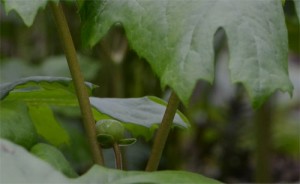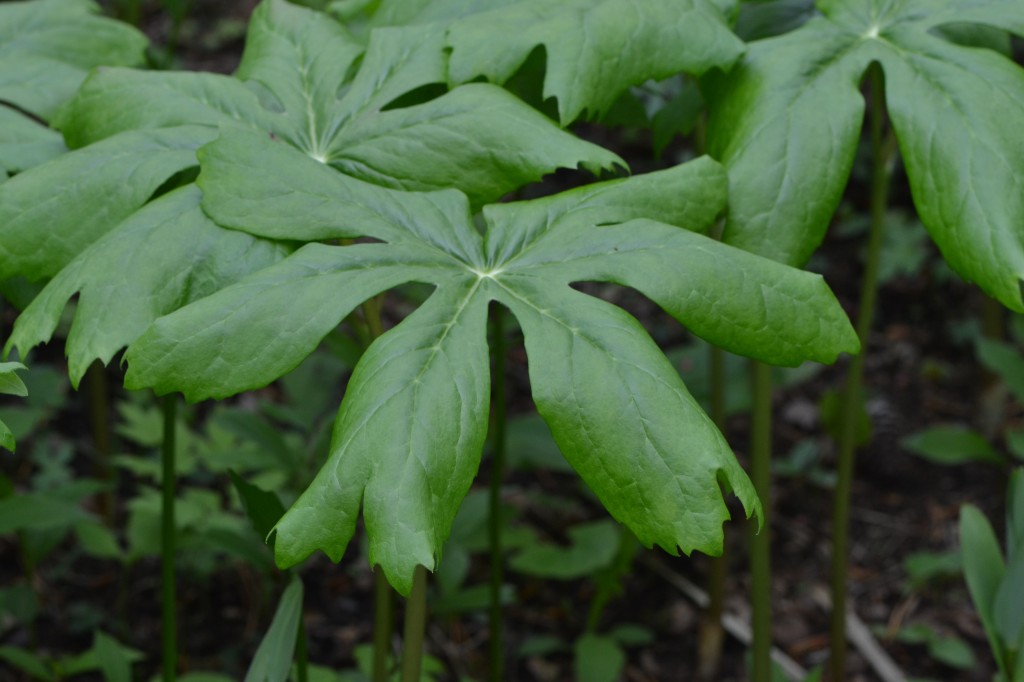
Mayapple flower about to bloom May 8 2011
Mayapple is a perennial herb with long rootstalks or underground stems, a native of the eastern United States and Canada, growing in shaded and moist woodlands. The entire plant attains a height of about twelve inches. I’ve seen established colonies, and they are simply breathtaking. The leaves are large, peltate, margin deeply cleft, from five to nine lobed, lobes pendant. It reminds me somewhat (on a much smaller scale) of the umbrella plant I observed in Costa Rica a few years back. Mayapple comes in two flavors (don’t all the good things?): The flowerless plants have only one leaf, while the flowering specimens always have two, which are opposite upon the stem apex, carrying the single flower in the split.
According to others (I have not observed or noticed, but then again I have allergies year round), the rhizomes, stems, and leaves have a very heavy, nauseous odor. Although my mayapple stand is too young this year, I could expect the flowers expand in May and the fruit to ripen in late summer. The fruit is a berry about the size of a plum. At first green, it changes to a soft yellow at maturity. It is not unlike a tomato in general appearance. When fully ripe it has a fragrant odor and tastes somewhat like the paw-paw. The fruit, and only the fruit, is edible. Everything else about the plant is poisonous! The fruit can be eaten raw, or cooked into a jam. Toxicity aside, the plant has many qualities biochemists would salivate over: The roots and rhizomes are used as a purgative. A resin from the plant, called padophyllin, has been used to treat venereal warts. The resin is extremely allergenic; it exhibits anti-tumor activity. In Appalachia, a tea of bark and roots is used to treat constipation. Externally, mayapple is used as a treatment for warts and skin eruptions. Internally, a very small amount of root may be used as a cathartic (laxative), a worm expellant, for jaundice, constipation, hepatitis, fever and syphilis.
I am hoping that Podophyllum peltatum will add character to an otherwise dark wasted corner of my yard.

Mayapple in all its glory at the museum of natural history, May 8 2011
| Scientific name: | Podophyllum peltatum |
| Common name: | mayapple |
| Other name: | mandrake root |
| Bloom time: | mid spring |
| Color: | white or near white |
| Light requirements: | partial shade to full shade |
| Zone: | 3 to 9 |
| Soil: | acidic to neutral |
| Water: | moist |
| Origin: | eastern North America |
In 2012 only one of the 3 plants returned, and it was a feeble attempt at that. This year, the rootstock seems to have recovered and expanded enough to produce multiple healthy looking stems. Unfortunately, the resident rabbit took care of those. Now it is a wait and see game on whether the rootstock will produce additional growth.
Just discovered this site and was surprised to see the may apple grows in New England. I’m from East Texas now living in the great plains and when seeing the photograph a feeling of nostalgia swept over me. It grows on hill sides covered with trees emerging from under a thick covering of last years leaves. I miss East Texas and especially this wonderful little plant. Thank you for your web site!